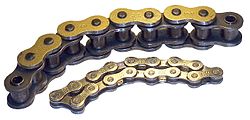This article has multiple issues. Please help improve it or discuss these issues on the talk page . (Learn how and when to remove these messages)
|


A chain [1] is a serial assembly of connected pieces, called links, typically made of metal, with an overall character similar to that of a rope in that it is flexible and curved in compression but linear, rigid, and load-bearing in tension. A chain may consist of two or more links. Chains can be classified by their design, which can be dictated by their use:
Contents
- Uses for chains
- Decoration
- Power transfer
- Security and restraint
- Traction, pulling and lifting
- Weapons
- Other uses
- Types of chain
- Connections
- History
- Symbolism
- Gallery
- See also
- References
- External links
- Those designed for lifting, such as when used with a hoist; for pulling; or for securing, such as with a bicycle lock, have links that are torus-shaped, which make the chain flexible in two dimensions (the fixed third dimension being a chain's length). Small chains serving as jewellery are a mostly decorative analogue of such types.
- Those designed for transferring power in machines have links designed to mesh with the teeth of the sprockets of the machine, and are flexible in only one dimension. They are known as roller chains, though there are also non-roller chains such as block chains.
Two distinct chains can be connected using a quick link, carabiner, shackle, or clevis. The load can be transferred from a chain to another object by a chain stopper.















